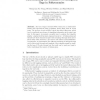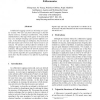EDBT
2009
ACM
14 years 4 months ago
2009
ACM
The tagging technique has been widely applied in existing Web 2.0 systems, where users label resources with tags for effective classification and efficient retrieval of resource...
HT
2010
ACM
14 years 4 months ago
2010
ACM
While recent research has advanced our understanding about the structure and dynamics of social tagging systems, we know little about (i) the underlying motivations for tagging (w...
HT
2010
ACM
14 years 4 months ago
2010
ACM
Collaborative tagging systems are popular tools for organization, sharing and retrieval of web resources. Their success is due to their freedom and simplicity of use. To post a re...
LAMAS
2005
Springer
14 years 5 months ago
2005
Springer
Use of tags to limit partner selection for playing has been shown to produce stable cooperation in agent populations playing the Prisoner’s Dilemma game. There is, however, a lac...
AUTOID
2005
IEEE
14 years 5 months ago
2005
IEEE
We present a wireless identification system that employs an optical communications link between an array of uniquely identifiable smart tags and an interrogator flashlight. As the...
MOBICOM
2006
ACM
14 years 5 months ago
2006
ACM
RFID tags are being used in many diverse applications in increasingly large numbers. These capabilities of these tags span from very dumb passive tags to smart active tags, with t...
SEMWEB
2007
Springer
14 years 5 months ago
2007
Springer
The use of tags to describe Web resources in a collaborative manner has experienced rising popularity among Web users in recent years. The product of such activity is given the nam...
ESWS
2007
Springer
14 years 5 months ago
2007
Springer
While tags in collaborative tagging systems serve primarily an indexing purpose, facilitating search and navigation of resources, the use of the same tags by more than one individu...
INFOCOM
2007
IEEE
14 years 5 months ago
2007
IEEE
A radio frequency identifier (RFID) system consists of inexpensive, uniquely identifiable tags that are mounted on physical objects, and readers that track these tags (and hence...
IAT
2007
IEEE
14 years 5 months ago
2007
IEEE
Collaborative tagging systems are becoming very popular recently. Web users use freely-chosen tags to describe shared resources, resulting in a folksonomy. One problem of folksono...


